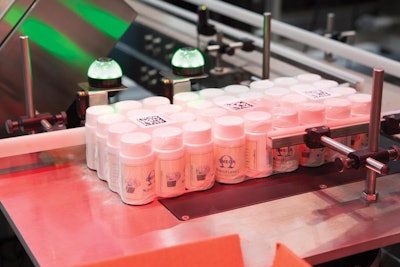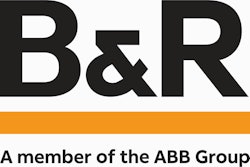A growing number of pharmaceutical manufacturers and their partners and vendors are adopting technologies to leverage the full potential of The Industrial Internet of Things (IIoT). The connectivity power of IIoT has helped the industry comply with regulations intended to keep drugs safe and to prevent counterfeit products from entering the supply chain. As more devices, equipment, and production lines become connected, keeping those connections secure from unauthorized access continues to be a top priority.
Because of e-pedigree and serialization requirements, the pharmaceutical industry has been at the forefront of IIoT breakthroughs in data sharing and connectivity in the last few years. New trends and technologies in the world of the IIoT for pharmaceutical manufacturing (sometimes referred to as IIoT-PM) will be on display at the co-located Pharma EXPO (McCormick Place, Chicago; Nov. 6 - 9) and PACK EXPO International 2016.
Pharma EXPO is co-produced by PMMI, The Association for Processing and Packaging Technologies and the International Society for Pharmaceutical Engineering (ISPE). Pharmaceutical professionals will be able to see modern processing and packaging equipment covering anti-counterfeiting, quality control and assurance, tamper-proof packaging, validation, and numerous other technologies.
Collaboration is key
According to Robert Muehlfellner, Corporate VP, Product Strategy and Innovation at B&R Automation (Booth #N-6141), the IIoT represents a convergence of Internet technology (IT) and operations technologies (OT), with an emphasis on data processing and security. In a manufacturing world that requires close collaboration with IT, to be successful in a security-conscious industry will require strong partnerships, he believes.
“Smaller equipment builders are being forced into the world of connectivity but sometimes lack in-house expertise to take advantage of it,” Muehlfellner says. “Regulations are also getting more complex, and they are not harmonized globally. Our challenge is to help customers adopt these technologies and become more compliant with regulations.”
B&R offers automated systems used in discreet manufacturing from controllers, I/O systems, motors and drives, to Human Machine Interfaces (HMI) and software. While B&R supports companies of all sizes, Muehlfellner notes it has found a particular niche with smaller manufacturers struggling with IIoT technologies.
Controlling access to data is one of the biggest concerns in the industry, which may seem a bit paradoxical in an age of close collaboration and information-sharing. “In the last decade the industry was all about getting machines connected to each other, and now we’ve shifted from ‘openness’ to security to prevent unauthorized data access and manipulation,” Muehlfellner says.
Managing data security and quantity
The need for data security has put a focus on the type of communication protocols used in the industry. Daymon Thompson, Automation Specialist for Beckhoff Automation (Booth #N-6125), notes that Open Platform Communications-United Architecture (OPC-UA) protocols have emerged as a standard for smart connectivity and data exchange in the pharmaceutical industry. Established by the OPC Foundation, OPC-UA is a vendor-neutral industrial M2M communication protocol that includes built-in data encryption.
“With OPC-UA you don’t need to be security experts to ensure safe data exchange, and it also provides interoperability among devices from different vendors,” Thompson says. He adds that other open and standardized communication protocols such as MQ Telemetry Transport (MQTT) and Advanced Message Queuing Protocol (AMQP) are also gaining importance because they offer fast and efficient data transmission.
While managing data security is important, another critical industry need is the ability to handle the vast quantities of data that IIoT technologies are able to capture. “Simply gathering massive amounts of data and having the ability to move it around anywhere in the world is not the end goal,” Thompson says. “Analytics technology is required to generate insights out of the data to help make informed, intelligent business and production decisions.”
To this end, Beckhoff has introduced a new software solution called TwinCAT Analytics that records and analyzes production data in IIoT and “smart” factory settings. When paired with cloud services or enterprise servers, it can help store large quantities of data while a software workbench performs cycle analysis, energy demand and RMS calculations directly on the controller. Beckhoff’s software options connect directly with Microsoft Azure and Amazon Web Services (AWS) cloud-hosting platforms.
Technology pioneered in the automotive industry
Serialization and sending data to a secure and centralized database are the keys to drug safety, according to Daniel Sanwald, Product Manager for Track & Trace at Bosch Packaging Technology (Booth #S-3514). Besides processing and packaging equipment, Bosch also manufactures hardware and software for pharmaceutical serialization, including printing, verification and checkweighing technologies.
Sanwald says Bosch has a history of connecting equipment and production lines dating back to the company’s presence in the automotive industry. “Bosch first used track and trace and serialization in the automotive market 15 years ago, and the technology helped make automobile production the most efficient industry in the world,” he says. “Today, the IIoT is driving new possibilities, and for Bosch this comes down to serialization. It dictates the future for how we connect our machines, and it influences our everyday business.”
Bosch’s CPI software manages serialization from allocating serial numbers to final aggregation steps, and it can connect single components, packaging lines and complete factories. The software is modular and can be deployed as part of an integrated application from a single source or combined with hardware from third-party suppliers.
Serialization—aggregation
Full aggregation and serialization—the ability to trace all units of sale through the supply chain—will not be fully required in the U.S. until 2023. However, according to Darren Meister, VP of Sales for IMA North America Inc. (Booths #S-3547 and W-527), a number of pharmaceutical manufacturers are gearing up now because other countries are adopting regulations sooner.
“Larger manufacturers are trying to meet these standards now due to sales of their products in certain countries requiring aggregation currently or in the near future,” Meister says. IMA North America provides automated tablet counting and filling equipment for the pharmaceutical and other industries.
Meister reports that IMA handles roughly 20 pharmaceutical serialization projects every year by helping companies integrate product handling, automation and traceability in their operations. At PACK EXPO International, IMA will be showcasing serialization technologies for printing and case packing.
Drive for adoption
Glenn Siegele, President of Omega Design (Booths #S-3530 and W-907) also notes an urgency to adopt aggregation solutions sooner than later to stay ahead of regulatory requirements. He says aggregation will bring greater product visibility in the pharmaceutical supply chain while adding an additional level of security compared to serialization alone.
“As a company we have put a strong focus on aggregation integrity, and we believe companies should physically aggregate products before they aggregate data on their packaging lines,” Siegele says. “This helps prevent things from slipping through the supply chain.”
Omega offers its “Fast Track” serialization modules for rapid deployment as well as custom solutions to help companies integrate packaging line equipment with data management software. Its Intelli-Pac options give manufacturers a choice of manual, semi- and fully-automated features.
In the IIoT age, Siegele warns that data access is not the only security concern. “As you connect more devices wirelessly, you have to be careful about viruses,” he says. Another concern with connectivity is the onslaught of data, which needs to be managed properly to prevent a potential slowdown in processing. The increased data, however, leads to automated and improved quality control, he says.
Simplifying serialization steps
Richard Bahr, president and CEO of MGS Machine (Booth #W-738) also notes a sense of resolve in the pharmaceutical industry with regard to adopting IIoT solutions with serialization. He says there has been a shift in mentality from the last decade when California’s ePedigree laws were enacted. “Companies are acting like the latest deadlines are real as opposed to when it was chiefly a California mandate.”
MGS Machine produces secondary packaging, product handling and line integration products that include cartoners, case packers and outsert applicators. Bahr says the company’s systems are “agnostic,” so they can integrate equipment with different vision and print OEM providers to meet customer specifications.
The company’s MatriX™ case packer enables a full view of collated cartons just prior to case loading. Bahr says that unlike other case packers, the MatriX performs physical aggregation and vision inspection all at once to ensure all coded cartons packed on cases belong to the same family. At PACK EXPO International MGS Machine will be rolling out its new CT200™ pharma-cartoner with print and vision capabilities integrated inside the cartoner. Each inspected unit will bear a serial number, which reduces the risk of products coming onto or off of lines that are not tracked, Bahr says.
As the IIoT transforms manufacturing in every sector, the pharmaceutical industry in particular is well positioned to leverage the benefits of data collection and improved OEE that is promised by a world of connected industrial assets. Keeping data collection safe and secure will continue to drive the development of technologies and protocols to ensure a safe global supply chain of medications.
Attendees of PACK EXPO International 2016 and Pharma EXPO will have an opportunity to see firsthand the latest in IIoT technologies. Together, the shows will feature more than 2,500 exhibitors and draw 50,000 attendees. Attendees will have access to both shows with one badge.




































